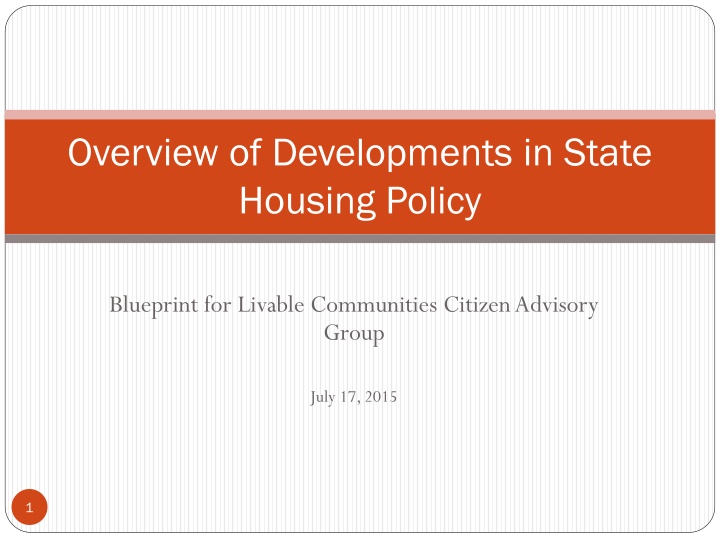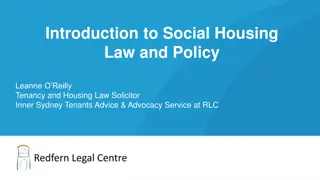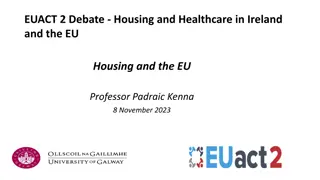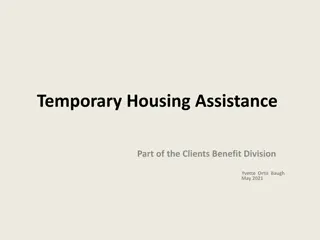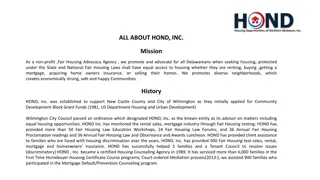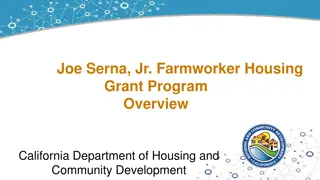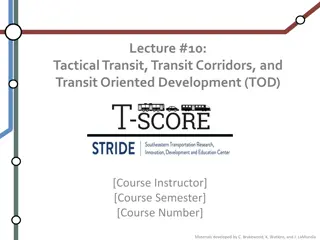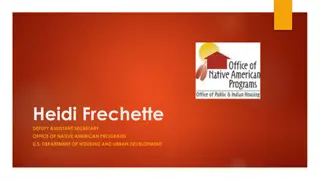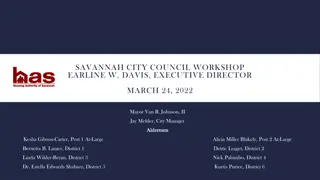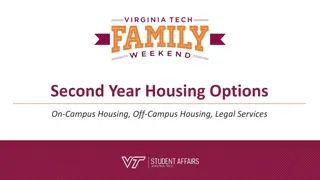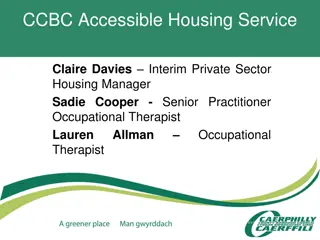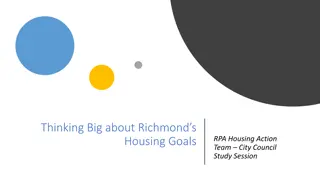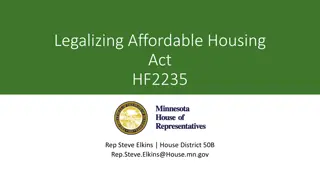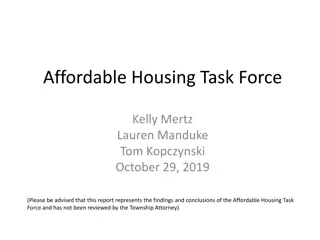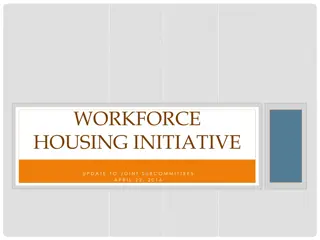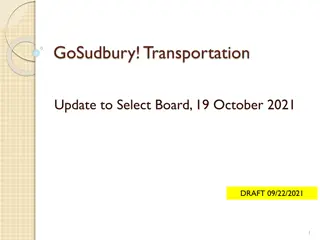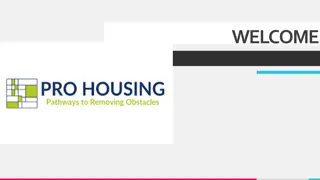State Housing Policy Blueprint for Livable Communities - Developments Overview
This overview highlights key developments in Virginia's state housing policy, focusing on initiatives like Executive Order 32, the Virginia Housing Trust Fund, and the State Housing Policy Advisory Council. It discusses efforts to address homelessness, housing for special needs populations, and the link between housing and economic development. The Virginia Housing Trust Fund allocation details and initiatives for reducing homelessness are also outlined.
Download Presentation

Please find below an Image/Link to download the presentation.
The content on the website is provided AS IS for your information and personal use only. It may not be sold, licensed, or shared on other websites without obtaining consent from the author.If you encounter any issues during the download, it is possible that the publisher has removed the file from their server.
You are allowed to download the files provided on this website for personal or commercial use, subject to the condition that they are used lawfully. All files are the property of their respective owners.
The content on the website is provided AS IS for your information and personal use only. It may not be sold, licensed, or shared on other websites without obtaining consent from the author.
E N D
Presentation Transcript
Overview of Developments in State Housing Policy Blueprint for Livable Communities Citizen Advisory Group July 17, 2015 1
Overview Statewide Housing Policy EO32 Virginia Housing Trust Fund Homeless Service System Community Integration for Persons with Intellectual and Developmental Disabilities National Disaster Resiliency Competition 2
State Housing Policy Executive Order 32 issued in October of 2014, directs Secretary of Commerce and Trade to assemble an advisory group to identify and implement actions that enable quality, affordable housing, which will strengthen families and communities and foster economic growth Policy is to focus on three key areas: Homelessness, especially veterans and youth Housing for special needs populations Linking housing to economic development and community revitalization 3
State Housing Policy Advisory Council is composed on a diverse group of leaders from across Virginia Held first meeting in March and scheduled to meet again in early September First action was to commission a research study to document the impact of housing on the broader state economy, the importance on housing in the economic development process, and how housing acts as a catalyst for community revitalization Advisory Council will report annually to the Governor on recommendations and findings 4
Virginia Housing Trust Fund Reduce the cost of homeownership and rental housing Provide continued support for efforts to reduce homelessness. General fund allocation for FY 15 and FY 16 $4 million in each year; combined into one $8 million resource Virginia Housing Trust Fund Structure and Use Plan - www.dhcd.virginia.gov Applications due September 3, 2015 5
Virginia Housing Trust Fund Allocation Loans Competitive Loan Pool Comprehensive Neighborhood Revitalization Pilot Grants $5.5M $1.5M Homeless Reduction Competitive Grant Pool $1.0M Administration $160,000 Total $8.16M 6
VHTF Key Provisions At least 80 percent of the Fund must be used as flexible financing for low-interest loans through eligible organizations. Up to 20 percent of the Fund may be used for grants for targeted efforts to reduce homelessness Loans structured to maximize leveraging opportunities and are repaid to the Fund Strong link back to state housing policy 7
VHTF Competitive Loan Pool Eligible uses for this 80 percent include: Affordable rental housing new construction, rehabilitation, acquisition Down payment and closing cost assistance for homebuyers Short, medium and long term loans to reduce the cost of homeownership and rental housing 8
VHTF Homeless Reduction Grants Up to 20 percent of the Fund may be used for grants for targeted efforts to reduce homelessness, including: Temporary rental assistance, not to exceed one year Housing stabilization services in permanent supportive housing Mortgage foreclosure counseling targeting localities with the highest foreclosure rates Pre-development assistance for permanent supportive housing and long-term housing options for the homeless 9
Homeless Services System Transformation since 2010 Move from a strictly shelter-based system to a broader system based on a housing first best-practice model Shifted funding to rapid re-housing 10
Homeless Services System Outcomes focused Decrease the length of time individuals experience homelessness Decrease the number of new entries to homelessness Decrease the number of individuals returning to homelessness Homelessness should be rare, brief and non-recurring 11
Homeless Services System Focused on Shelters Focused on Prevention and RRH Focused on Outputs Focus on Outcomes CoC-based Funding Funding Projects Funding Community- based Solutions 12
Homeless Services System Combined federal and state resources into one program (Virginia Homeless Solutions Program) Community based application and funding Organizations must work together at community level to create an effective emergency crisis response system to homelessness 13
Reduction in Homelessness Total Homeless Persons Virginia's CoC January Point - in - Time Count 23% decrease from 2010 - 2015 10000 9500 9080 8816 9000 8424 8500 8000 7625 7500 6992 7020 7000 6500 2010 2011 2012 2013 2014 2015 14
Reduction in Homelessness Households with Adults and Children Virginia's CoC January Point - in - Time 22.6% decrease from 2010 - 2015 1300 1181 1200 1145 1094 1100 984 1000 914 883 900 800 700 600 2010 2011 2012 2013 2014 2015 15
Reduction in Homelessness Veterans Virginia's CoC January Point - in - Time Count 34% decrease from 2012 - 2015 1000 900 881 800 719 700 620 610 600 500 400 2012 2013 2014 2015 16
Additional Resources FY 2016 $500,000 for rapid re-housing $500,000 for rapid re-housing for veterans (all veterans eligible regardless of discharge status) 17
Governors Coordinating Council on Homelessness Ending Veteran Homelessness by 2015 Youth homelessness Interagency Partnership to Prevent and End Youth Homelessness Performance and Impact focus on data Solutions H Initiative; intersection of criminal justice system and homelessness 18
Housing and Supportive Services Settlement decisions have expanded the reach of Olmstead to state and federal policy Key Principles in Settlement Agreement: Reduce unnecessary segregation Prevent of segregation (Re) Design systems and access to resources including housing 19
Housing and Supportive Services Virginia has a commitment to ensure the intent of the American with Disabilities Act (ADA) and the Olmstead decision. Launched an intensive community engagement initiative to increase integrated community based housing with supportive services in the communities with the largest number of individuals impacted by the Department of Justice Settlement Hired a Program Manager to coordinate state agency efforts and serve as point of contact for community efforts 20
Housing and Supportive Services 100 Day Challenge Model Focused on Northern Virginia, Hampton Roads, and Greater Richmond Requires broad participation: CSBs, CILs, RHAs, local governments, nonprofits Updates, goals, partners, and more available at: www.vahss.org 21
HSS Process 23
HSS Lessons Learned 1. Increase community services capacity identify supports critical for successful community tenure---align capacity building and investments with what works 2. Expand the supply of affordable housing establish a targeting approach as part of the overall effort 3. Tap into the existing rental market(s) establish a marketing strategy 24
HSS Lessons Learned 4. Establish a partnership agreement build strong alliances 5. Establish a referral process streamline access 6. Build it and they will come inclusion, choice and location matters 25
National Disaster Resiliency Competition To provide resources to help communities plan and implement disaster recovery that makes them more resilient to future threats while improving quality of life and making communities more resilient to economic stresses or other shocks. To fully engage stakeholders about the impacts of climate change and to develop pathways to resilience based on sound science. To leverage investments from the philanthropic community to help communities define problems, set goals, explore options, and craft solutions. 26
National Disaster Resiliency Competition Virginia invited to Phase II project identification and implementation The minimum grant award is $1,000,000. The maximum award is $500,000,000. Applications due October 27, 2015. 27
Target Area Hampton Roads area, to include the Eastern Shore of Virginia. Qualifying communities include: Cities of Chesapeake, Hampton, Newport News, Norfolk, Poquoson, Portsmouth and Accomack County Presented best opportunity in terms of available data to demonstrate unmet need. Numerous prior studies on climate change and sea level rise. Critical military, economic, and environmental assets. Norfolk already participating in Rockefeller s 100 Resilient Cities program. Ongoing meetings and engagement with localities and potential partners. 28
Our Purpose Virginia will surface, test and refine the best strategies for building resilient communities across a range of environments by developing the model seaport region that derives its economic vitality from the water. 29
Project Goals Align the region s cities in a common effort, focused on their shared seaport, and on their common interest in addressing the challenges and opportunities associated with rising water. Unite the Region Build Water Management Solutions Imagine and build new technology, methods, and approaches to adapt seacoast communities to the challenges and opportunities of rising waters, turning the region into a coastal resilience laboratory where water related research and innovation flourish. Leverage shovel ready water management projects, to create cross-disciplinary, quantifiably measurable, improvements in the region s physical, social, and economic ability to adapt to, withstand, and recover from rising water related disruptions. Create Resilience Strengthen Vulnerable Neighbor- hoods Use water management projects, in conjunction with Livability Principles, to address known rising water related vulnerabilities in neighborhoods where our most vulnerable citizens live and work. Leverage the grant s water management projects to jumpstart a Hampton Roads regional business cluster, where innovation and entrepreneurship flourish, a place focused on seaport operations, and on new water management solutions for seacoast land use and livability. Improve Economic Vitality 30
Community Engagement Priority for broad stakeholder participation. State Federal Local Nonprofits Community groups Faith-based organizations Private businesses (utilities, telcos, more) Community stakeholders, including residents, businesses, public and private nonprofit agencies, must be engaged in discussing and identifying unmet recovery and resilience needs, and designing and selecting approaches to address the needs. Outreach activities should target populations that are among the most vulnerable to future threats and hazards, including climate change. 31
Innovation Emphasis on innovative design and community involvement. The Rockefeller Foundation convened resilience workshops around the country and continue to provide technical assistance. Opportunity to address broad range of activities: Acquisition Relocation Elevation Infrastructure hardening Pilot projects Water management systems Community communication systems Research and Development Economic Development / Business Accelerator Pitch project to other Federal agencies and philanthropic groups. Replicate. 32
